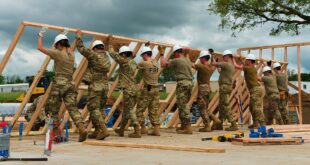BAGHDAD – A U.S. Army helicopter crashed yesterday in a hail of gunfire north of Baghdad, police and witnesses said – the fourth lost in Iraq in the last two weeks. The U.S. command said two crew members were killed, and the top U.S. general conceded that insurgent ground fire had become more effective.
A brief U.S. military statement gave no reason for the crash and did not identify the type of aircraft. A Pentagon official said it was an Apache attack helicopter, which carries two crew members.
The official spoke on condition of anonymity because he was not authorized to release the information. Another Apache crashed Sunday during heavy fighting with a Shiite cult near Najaf, also killing two soldiers.
Iraqi police and witnesses said the latest crash occurred about 7:30 a.m. as two Apaches were flying along a well-established air route near Taji, a major U.S. base about 12 miles north of Baghdad.
One helicopter was struck by heavy machine-gun fire but continued flying, the witnesses said. The other helicopter banked sharply and flew back toward the source of fire, apparently to attack the target.
But that helicopter was also struck by ground fire, exploded in a ball of fire, and crashed, the witnesses said. The other helicopter flew away, they said. The witnesses spoke on condition of anonymity, fearing for their safety.
The United States has lost more than 50 helicopters in Iraq since May 2003, about half of them to hostile fire.
The loss of four helicopters since Jan. 20 has raised new questions about whether Iraqi insurgents are using more sophisticated weapons or whether U.S. tactics need changing.
Three of the latest crashes involved Army helicopters – two Apaches and one Black Hawk. The fourth was an OH-6A observation helicopter operated by the Blackwater USA security firm. All were believed shot down, and 20 Americans, including four civilians, died in the crashes.
In Washington, Gen. Peter Pace, chairman of the Joint Chiefs of Staff, acknowledged that insurgent ground fire in Iraq “has been more effective against our helicopters in the last couple of weeks.”
Pace said it was unclear whether “this is some kind of new tactics or techniques that we need to adjust to.”
The Islamic State of Iraq, an al-Qaeda-linked group, claimed yesterday that it shot down the Apache near Taji in a statement posted on an extremist Web site.
“God has granted new ways for the soldiers of the State of Iraq to confront your aircraft,” the statement said.
Iraqi insurgents have used heavy machine guns, rocket-propelled grenades, and shoulder-fired SA-7 antiaircraft missiles. U.S. officials believe Iran is supplying Shiite militias with new weapons, including more powerful roadside bombs, Katyusha rockets, and a newer class of rocket-propelled grenades.
Some of those weapons could have found their way into the hands of Sunni insurgents, who operate around Taji.
The U.S. military relies heavily on helicopters to avoid roadside bombs and insurgent ambushes. Any new threat to helicopters would be a serious challenge to the military as it gears up for a major crackdown against Sunni insurgents and Shiite militias in Baghdad.
Elsewhere, the U.S. command said 18 insurgents were killed in fighting Thursday night and yesterday after insurgents opened fire on the Americans from several positions in Ramadi, 70 miles west of Baghdad. No civilian or U.S. casualties were reported, the military said.
The U.S. military said six more troops died Thursday, two in fighting in Anbar province, one of an apparent heart attack and three in vehicle accidents.
The deaths raise to at least 3,092 the number of U.S. military personnel who have died since the Iraq war started in March 2003, according to an Associated Press count. At least 2,480 died as a result of hostile action, according to the military’s numbers.
 Eurasia Press & News
Eurasia Press & News



